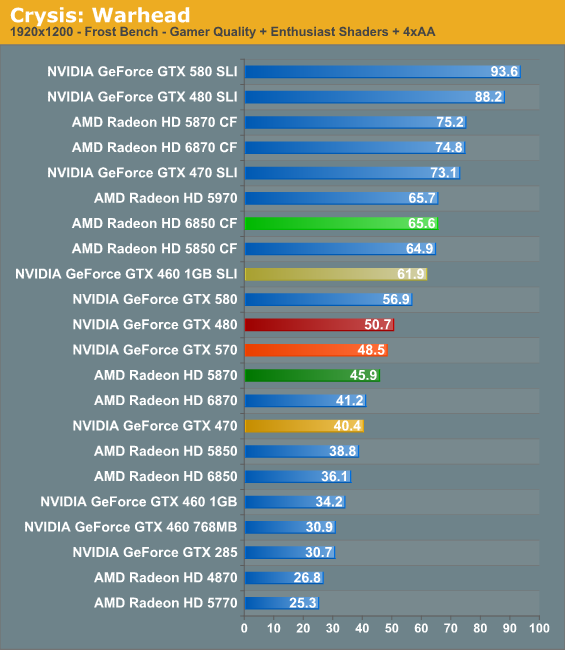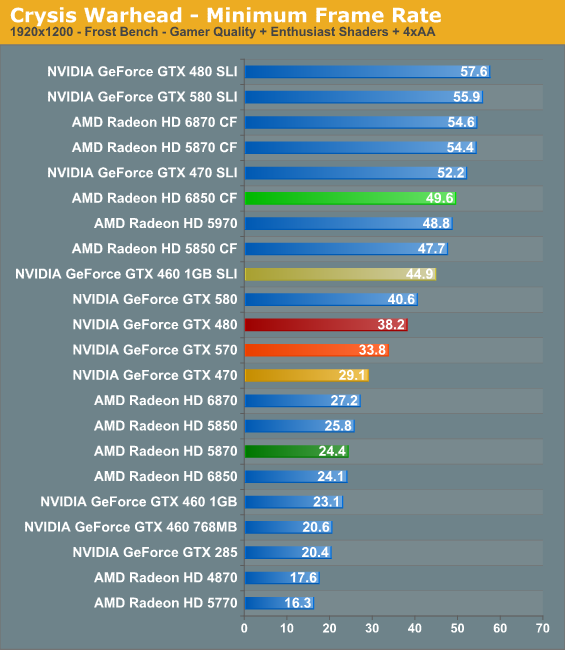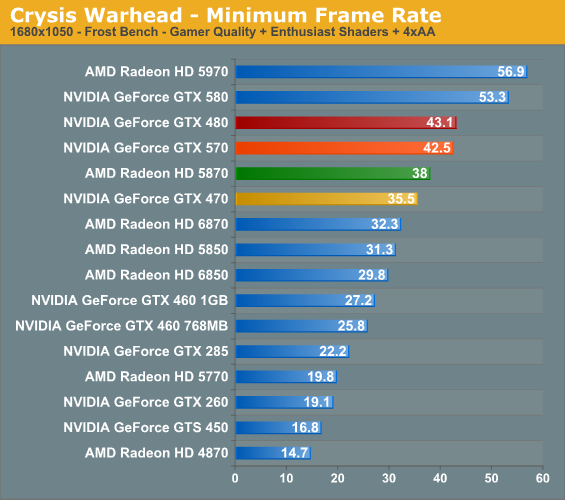NVIDIA's GeForce GTX 570: Filling In The Gaps
by Ryan Smith on December 7, 2010 9:00 AM ESTCrysis: Warhead
Kicking things off as always is Crysis: Warhead, still one of the toughest game in our benchmark suite. Even 2 years since the release of the original Crysis, “but can it run Crysis?” is still an important question, and the answer continues to be “no.” While we’re closer than ever, full Enthusiast settings at a playable framerate is still beyond the grasp of a single card.



Crysis end up setting the stage for the rest of this article. As a GTX 480 replacement the GTX 570 is effectively tied with it at 2560 and 1680, and only at 1920 do we see the GTX 570 fall behind by all of 4%. Meanwhile compared to the GTX 470 it’s 20% faster (and 40% more expensive), while it falls to the GTX 460 1GB SLI by over 10%. Overall the GTX 570 is at near parity with the GTX 480, and should be equally capable of playing just about everything at 1920.
As for AMD’s cards, the 5870 (which was never too far behind the GTX 480) nips at the GTX 570’s heels – at times the GTX 570 is no more than 5% faster and no better than 15% faster, showcasing why the 5870 is a threat to the GTX 570 as a value threat. Meanwhile the 6850 CF is tops here at 1920 by a wide margin for only around $20-$30 more than the GTX 570. As was the case with the GTX 580, a pair of lesser AMD cards is going to offer better gaming performance in exchange for the drawbacks of a multi-GPU setup.



Looking at our minimum framerates, the story is much the same. Outside of 2560 where the extra memory provides a stark advantage for the NVIDIA cards, the GTX 570 and GTX 480 are close together except for 1920 where the 570 falls behind by a bit more than we’d expect. The 5870 isn’t nearly as threatening here as it is with average framerates, but the 460SLI/6850CF configurations are still well ahead.










54 Comments
View All Comments
TheHolyLancer - Tuesday, December 7, 2010 - link
likely because when the 6870s came out they included an FTW edition of the 460 and was hammered? Not to mention in their own guild lines they said no OCing in launch articles.If they do do OC comp, most likely in a special article, possibly with retail brought samples rather than sent demos...
Ryan Smith - Tuesday, December 7, 2010 - link
As a rule of thumb I don't do overclock testing with a single card, as overclocking is too variable. I always wait until I have at least 2 cards to provide some validation to our results.CurseTheSky - Tuesday, December 7, 2010 - link
I don't understand why so many cards still cling to DVI. Seeing that Nvidia is at least including native HDMI on their recent generations of cards is nice, but why, in 2010, on an enthusiast-level graphics card, are they not pushing the envelope with newer standards?The fact that AMD includes DVI, HDMI, and DisplayPort natively on their newer lines of cards is probably what's going to sway my purchasing decision this holiday season. Something about having all of these small, elegant, plug-in connectors and then one massive screw-in connector just irks me.
Vepsa - Tuesday, December 7, 2010 - link
Its because most people still have DVI for their desktop monitors.ninjaquick - Tuesday, December 7, 2010 - link
DVI is a very good plug man, I don't see why you're hating on it.ninjaquick - Tuesday, December 7, 2010 - link
I meant to reply to OP.DanNeely - Tuesday, December 7, 2010 - link
Aside from apple almost noone uses DP. Assuming it wasn't too late in the life cycle to do so, I suspect that the new GPU used in the 6xx series of cards next year will have DP support so nvidia can offer many display gaming on a single card, but only because a single DP clockgen (shared by all DP displays) is cheaper to add than 4 more legacy clockgens (one needed per VGA/DVI/HDMI display).Taft12 - Tuesday, December 7, 2010 - link
Market penetration is just a bit more important than your "elegant connector" for an input nobody's monitor has. What a poorly thought-out comment.CurseTheSky - Tuesday, December 7, 2010 - link
Market penetration starts by companies supporting the "cutting edge" of technology. DisplayPort has a number of advantages over DVI, most of which would be beneficial to Nvidia in the long run, especially considering the fact that they're pushing the multi-monitor / combined resolution envelope just like AMD.Perhaps if you only hold on to a graphics card for 12-18 months, or keep a monitor for many years before finally retiring it, the connectors your new $300 piece of technology provides won't matter to you. If you're like me and tend to keep a card for 2+ years while jumping on great monitor deals every few years as they come up, it's a different ballgame. I've had DisplayPort-capable monitors for about 2 years now.
Dracusis - Tuesday, December 7, 2010 - link
I invested just under $1000 in a 30" professional 8-bit PVA LCD back in 2006 that is still better than 98% of the crappy 6-bit TN panels on the market. It has been used with 4 different video cards, supports DVI, VGA, Component HD and Composite SD. Has an ultra wide color gamut (113%), great contrast, matt screen with super deep blacks and perfectly uniform backlighting along with mem card readers and USB ports.Display Port, not any other monitor on the market offers me absolutely nothing new or better in terms of visual quality or features.
If you honestly see an improvement in quality spending $300 ever 18 months on a new "value" displays then I feel sorry for you, you've made some poorly informed choices and wasted a lot of money.